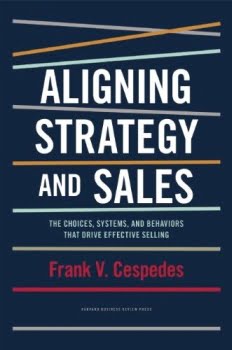
What does it take to be effective? Moreover what does it take to be effective at the right time? Given the speed of the Internet, success is becoming more dependent on being systematic where it counts. Such organization has potentially great value when strategy and sales are aligned.
To gain that alignment in a successful way, consider the book Aligning Strategies and Sales: The Choices Systems and Behaviors That Drive Effective Selling by Frank Cespedes. The author is a senior lecturer at Harvard Business School. I received an advanced copy through Harvard Business Review and was intrigued by the author’s earnest effort to make selling meaningful for those who struggle to organize sales.
When Sales Affects Your Whole Organization
This book looks at strategy and sales at what the link needs to be to make sales actually happened to business. It is a more advanced book than a book I reviewed a few years back, Dave Lakhani’s How to Sell When No One is Buying.
In that book, Lakhani highlights tactics in the sales trenches and implementation. Cespedes highlights implementation, but with an overview of those tactics in context of an organization. He writes that much is written about strategy but very few books have focused on the actual link. I found Cespedes makes a great distinction on when meaningful strategy activity really begins.
Saying No Leads to More Meaningful Activity
Chapter 5 starts with the idea of evaluating projects relative to the strategy and saying no. This advice has been increasingly appearing in text as of late. See Adrienne Graham’s book No You May Not Pick My Brain or Eli Broad’s The Art of Being Unreasonable. Although each of these books offer differing main subject matter, the art of being paid for your work in the former, leadership in the latter, the idea of saying no to achieve something greater appears in each.
Cespedes enhances the concept by framing the concept around strategy. What I liked about the book is that such framing is written well for organizational managers as much as for small business owners. The end result is text that can help growing small businesses make enterprise level decisions and appreciate the potential results more clearly. Check out this comment to get a sense of what a “no” should do for a sales strategy:
“Without “no” you get what most companies get as a result of planning meetings: A list of possibilities, a vision at 30,000 feet that many managers simply do not understand or series of incremental initiatives for the next year. In fact, if you attend a strategy meeting after the meeting, and it’s not clear what services you would not provide and what activities in sales in other areas you will not invest in, then the odds are that it was not a strategy meeting. It may have been a useful motivational meeting, and people may leave feeling good about the company. But without clarity about “no” as well as “yes” there is no strategy.”
There are also chapters on training and implementation, with Cespedes highlighting that strategy is a process instead of an overnight change in an organization:
“The basic idea is that aligning strategy and sales requires an ongoing systemic approach and not, unfortunately, a quick-fix motivational speech or an allegedly all-purpose selling methodology. You must integrate three factors internally to the sales organization—the people involved, the control systems that influence their behaviors, and how those controls are applied in the sales force and company environment—with factors external to the sales organization: Your business strategy and the target market/customer characteristics that (if you in fact have a strategy) flow from those strategic choices.”
All along the way there are figures and charts that highlight the processes that are encountered and, according to Cespedes, must be managed. Check out this quote regarding salespeople:
“…salespeople (more than others in a company) must interact internally with people in marketing, operations, engineering, finance, and others across the firm, and depending upon the buying process, they deal externally with a host of people. Each group has its own operating procedures. Yet the essence of most selling jobs is to manage and, in practice, to negotiate this boundary between the selling organization and potential customers. That’s one reason why coordination across the organization…is so important to effective selling.”
Cespedes goes on to note examples of how external clients impact a sales person’s performance, such as how international sales for Ford and Pfizer are managed differently.
Later chapters are dedicated to operational concerns in which pitfalls can appear. Chapter 9 illustrates how sales compensation and incentives are misused; Chapter 10 looks at performance reviews; and Chapter 11 takes a look at sales managers.
This book will help guide your organization’s sales strategy and highlight the tactics that will leverage that strategy effectiveness. You’ll see how to best select the sales support activities that mean most and remove silos that quickly erode communications.
Cespedes states that “a desk is a dangerous place from which to view the world, especially the sales world.” Read Aligning Strategies and Sales , and you’ll view the dangers…and how to best avoid them.
[“source-smallbiztrends”]




